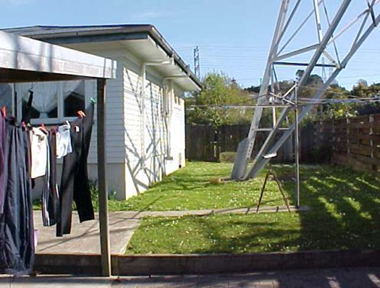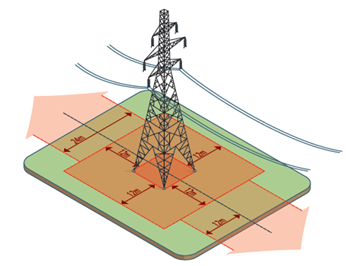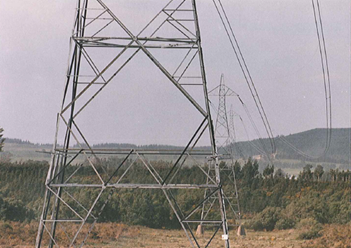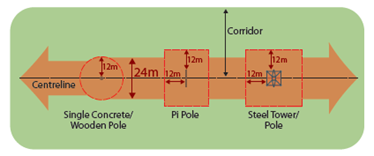Land use and development near National Grid assets (including transmission lines, poles, towers and substations) must be managed carefully so it does not create unacceptable safety risks, block Transpower’s access for vital maintenance and upgrade work (including emergency repairs), or otherwise restrict the efficient and safe operation of the National Grid.
If you want to develop your property and there are National Grid assets directly overhead or nearby, it is important that you contact Transpower to discuss your plans.
Enquiries
General building and land use enquiries are typically managed by our Landowner Relations Advisors (LORA) and Landowner Liaison Officers (LOLO). You can find out who your local LOLO is here - https://www.transpower.co.nz/our-work/landowners-and-developers/landowners/contact-our-landowner-team OR call 0508 LANDOWNER / 0508 526 369637
Enquiries about sensitive activities (such as residential housing), subdivision, or development that requires, or may require, resource consent from council, are managed by Transpower’s Environment Policy and Planning Group (EPPG). These resource consent enquiries are what can be submitted on Pātai (click here).

What are the Issues?
Incompatible land use and development must be set back from National Grid assets to avoid compromising their ongoing operation, maintenance, upgrading and development, or the safety of those living or working around them.
Electrical and physical hazards due to incompatible activities can result in faults or power outages which have flow on effects for the security of the network. These can be inconvenient and expensive not only to Transpower, but to consumers. The main issues are:
- Underbuild;
- Blocking off access to support structures;
- Earthworks undermining the integrity of support structures (towers, poles);
- Risks of electrical hazard;
- Noise and visual effects;
- Inconvenience to landowners, neighbours and the public.

How do we manage these issues?
To address these issues, we use National Grid Yards, Subdivision Corridors and Substation Corridors to describe the areas around our transmission lines and substations where you need to take care and consider Transpower in your design. Your council might describe these areas in other ways, like buffer or transmission corridor setbacks; but they all refer to the same need to restrict incompatible activities or inappropriate development around National Grid assets.
This approach is consistent with the government issued National Policy Statement on Electricity Transmission 2008 (NPSET), a planning document under the Resource Management Act 1991 (RMA). The NPSET sets national policy direction requiring the appropriate development of land under and near National Grid assets. All plan documents (such as district plans and regional policy statements) must give effect to the objective and policies in the NPSET. Councils must also have regard to the NPSET, when granting resource consents. All plan documents (such as district plans and regional policy statements) must give effect to the objective and policies in the NPSET; and Councils must also have regard to the NPSET, when considering resource consent applications.

What are Subdivision Corridors?
The National Grid Subdivision Corridor is the area where Transpower needs to be involved in the design and layout of a subdivision (and its subsequent land use). It is the area up to 39 m either side of the centreline of a transmission line. This is the general extent of the area where the conductors (wires) are physically present - as the lines can swing out this far in high wind conditions. The size of the corridor differs depending on the voltage and type of support structure. In the Auckland Unitary Plan, the National Grid Subdivision Corridor has varying widths in depending on the maximum “blowout”, or swing, of the conductors (“wires”) on each individual line span (the distance between the support towers or poles).
What can I do in the National Grid Subdivision Corridor?
Subdivision is an opportunity to design new development in a manner that takes the lines into account – including ensuring allotments are of a size that can be safely developed. Many activities, including residential buildings can occur within the Subdivision Corridor, provided they are set back from the National Grid Yard.

What are National Grid Yards?
Within the National Grid Subdivision Corridor is a narrower National Grid Yard (NGY). The NGY is the area beneath, and immediately next to, National Grid lines (including their support structures).
It is a 12m setback either side of the centreline of a National Grid line and 12m in any direction from the outer edge of a National Grid line structure. This is reduced to a 10m setback where the line is a single pole line, although the distances from the structures remain the same.
What can I do in the National Grid Yard?
Transpower seeks to keep the National Grid Yard (NGY) free of buildings and structures and to manage land use and activities that could pose a risk to your safety or to the safe and efficient operation of the National Grid. What can (and can’t) be established within the NGY depends on where your site is located. Existing activities within the NGY can continue as is.
In any location (urban or rural), Transpower will not support any new or extended sensitive activities within the NGY. In many situations it is possible to design around National Grid lines and land within the NGY can be utilised for other activities.
If you wish to establish a new building or structure, subdivide, or substantially change land uses within the National Grid Subdivision Corridor or NGY, please get in contact with us through this Enquiry Portal – Pātai.
Sensitive Activities /Buildings
These are activities that are more likely to be affected by National Grid lines relative to other activities. A Sensitive Building includes: New Dwelling/s (including minor dwellings, garage conversions, papakāinga, visitor accommodation, boarding houses, integrated residential development, retirement villages, supported residential care); School / educational facilities; Hospitals, healthcare facilities or care centres. Local planning rules may define other sensitive activities.
City/District Plan Rules
Your Council’s District or City Plan may give effect to the NPSET by including specific rules about subdivision, land use and development near National Grid transmission lines and substations. They may use the same terms as Transpower – National Grid Yard, Subdivision and Substation Corridor; or your council may describe the areas around our assets in other ways, like: buffer or transmission corridor setbacks; but they all refer to the same need to restrict incompatible activities or inappropriate development around National Grid assets.
Each District/City plan is different and may or may not include rules restricting development around National Grid assets. Please ensure you contact your Council in the first instance to discuss what National Grid rules may apply to your property and proposal, including whether or not resource consent is, or may be, required. Although National Grid transmission lines are Transpower assets, the rules applying to them are Council rules within their Plans.
What else do I need to know about?
In addition to our National Grid Yard and Subdivision Corridors, there are also a number of important regulations such as the NZ Electrical Code of Practice for Electrical Safe Distances (NZECP34:2001) that contains mandatory requirements and safe separation distances for development near existing National Grid lines. You can find more information on NZECP here.
